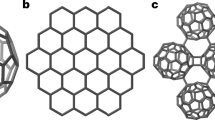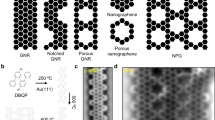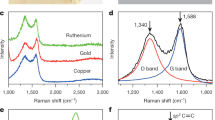Abstract
THE discovery of fullerenes1,2 and carbon nanotubes3,4 has led to the realization that it should be possible to tailor the properties of graphitic sheets if their geometry can be controlled5–7. In exploring these possibilities, we have found that the folding and tearing of graphitic sheets follow well defined patterns which seem to be governed by the formation of sp3-like line defects in the sp2 graphitic network. Our studies with the atomic force microscope and scanning tunnelling microscope reveal that these folds and tears occur preferentially along the symmetry axes of graphite, and that 'ripples' are observed in the curved portions of the folds. We also see ripples in deformed carbon nanotubes. They lie along the directions for which sp3-like line defects can form most easily to relieve strain. Our ab initio molecular orbital calculations indicate that the ripples stabilize the π-electronic energy in the bent structures with the total energy balance being determined by the amount of nuclear repulsion. These results provide insight into the geometries that graphitic structures will preferentially accommodate, and the properties that might ensue.
This is a preview of subscription content, access via your institution
Access options
Subscribe to this journal
Receive 51 print issues and online access
$199.00 per year
only $3.90 per issue
Buy this article
- Purchase on Springer Link
- Instant access to full article PDF
Prices may be subject to local taxes which are calculated during checkout
Similar content being viewed by others
References
Kroto, H. W., Heath, J. R., O'Brien, S. C., Curl, R. F. & Smalley, R. E. Nature 318, 162–164 (1985).
Kratschmer, W., Lamb, L. D., Fostiropoulos, K. & Huffman, D. R. Nature 347, 354–358 (1990).
lijima, S. Nature 354, 54–58 (1991).
Ebbesen, T. W. & Ajayan, P. M. Nature 358, 220–222 (1992).
Mackay, A. L. & Terrones, H. Nature 352, 762 (1991).
Mintmire, J. W., Dunlap, B. I. & White, C. T. Phys. Rev. Lett. 68, 631–634 (1992).
Hamada, N., Sawada, S. & Oshiyama, A. Phys. Rev. Lett. 68, 1579–1581 (1992).
Ebbesen, T. W. et al. Chem. Phys. Lett. 209, 83–90 (1993).
Bacon, R. J. Appl. Phys. 31, 283–290 (1960).
Ruoff, R. D., Tersoff, J., Lorents, D. C., Subramoney, S. & Chan, B. Nature 364, 514–516 (1993).
Tanaka, K., Ohzeki, K., Nankai, S. & Yamabe, T. J. Phys. Chem. Solids 44, 1069–1975 (1983).
Murayama, H. & Maeda, T. Nature 345, 791–793 (1990).
Ugarte, D. Chem. Phys. Lett. 198, 596–602 (1992).
Huzinaga, S. Gaussian Basis Sets for Molecular Calculations (Elsevier, Amsterdam, 1984).
Author information
Authors and Affiliations
Rights and permissions
About this article
Cite this article
Hiura, H., Ebbesen, T., Fujita, J. et al. Role of sp3 defect structures in graphite and carbon nanotubes. Nature 367, 148–151 (1994). https://doi.org/10.1038/367148a0
Received:
Accepted:
Issue Date:
DOI: https://doi.org/10.1038/367148a0
This article is cited by
-
Continuously processing waste lignin into high-value carbon nanotube fibers
Nature Communications (2022)
-
Improved electrochemical performance of carbon nano-onions conductive additives for LiFePO4/C cathode material
Ionics (2022)
-
Review on the recent progress in the preparation and stability of graphene-based nanofluids
Journal of Thermal Analysis and Calorimetry (2020)
-
Controllable edge modification of multi-layer graphene for improved dispersion stability and high electrical conductivity
Applied Nanoscience (2019)
-
Graphene: from synthesis to engineering to biosensor applications
Frontiers of Materials Science (2018)
Comments
By submitting a comment you agree to abide by our Terms and Community Guidelines. If you find something abusive or that does not comply with our terms or guidelines please flag it as inappropriate.



